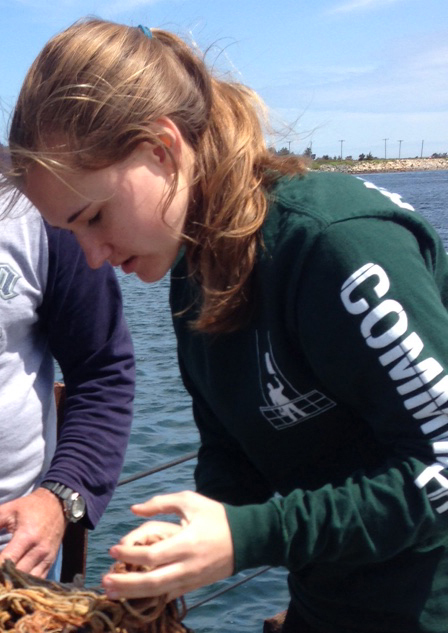Lab Schools student adds to ocean genome repository

Grace Anderson just made her first contributions to biodiversity science. Anderson, a student at the University of Chicago Laboratory Schools, spent the month of May at the MBL working alongside David Remsen, manager of the MBL Marine Resources Department.
Sampling from the ocean on the MBL’s collecting boat, the Gemma, and foraging for other species along the shoreline, the two collected 80 samples from 55 different marine species to contribute to the Ocean Genome Legacy (OGL) biorepository at Northeastern University.
OGL is collecting DNA from a diverse array of marine species, providing researchers with the raw material for biological discovery. Anderson supplied OGL with tissue samples from a variety of specimens, from starfish to comb jellies, including seven marine model organisms (see OGL article on model systems here).*
After visiting the MBL with the Lab Schools in 2015, Anderson asked to return to Woods Hole during the latter half of her senior year as an external educational experience. “I knew I wanted to come back [to the MBL] because we really only got a sample of the kind of research they do,” said Anderson. Remsen came up with the dual-purpose mission of collaborating with the OGL and introducing Anderson to the domain of biodiversity informatics.
The premise of the partnership was simple: Northeastern would supply an empty sample kit, and Anderson would return it full of tissues from marine species, pictures of the organisms, and electronic data on each organism (what is it and who found it, where and when).
“The tissue sampling project was a really great introduction into marine biology, because I got to learn how to identify a wide range of specimens and where to find their natural habitats,” Anderson recalled.
 Aboard the Gemma, Grace Anderson collects starfish (A. forbesi) using a dredge mop.
Aboard the Gemma, Grace Anderson collects starfish (A. forbesi) using a dredge mop.In order to generate an even more complete record of Anderson’s endeavors in the field and at the lab bench, Remsen created a profile for Anderson on a social network site known as iNaturalist. This site allows Anderson to document her observations and share them with others, using unique and universal digital “identifiers” to maintain the integrity of her specimen data, even when it is stored in various locations and formats (i.e., the specimens themselves at MBL, the tissue stored at OGL, the iNaturalist record detailing location of collection, or future online genetic sequences of the species). These diverse datasets are now tied to the original sample, which in turn is tied to Anderson. Since the single identifier links all facets of the specimen data, acquiring one facet permits access to all.
“Undergoing the process of using universal identifiers for every specimen helped me to better understand the importance of tracking scientific data," Anderson said.
iNaturalist, to which anyone can contribute, is also linked to the Global Biodiversity Information Facility (GBIF), the primary means by which researchers worldwide access biodiversity data.
“In this regard, iNaturalist is a gateway to a much more robust and scientifically important access point to Anderson’s data,” said Remsen. “We wanted to make sure that anyone who has an interest in anything about her observations gets the full picture, and that she can be acknowledged.”
_____________
*The model organisms MBL supplied to OGL included: Doryteuthis pealeii (longfin inshore squid); Saccoglossus kowalevskii (acorn worm); Mnemiopsis leidyi (comb jelly); Ciona intestinalis (vase tunicate); Limulus polyphemus (horseshoe crab); Nematostella vectensis (starlet sea anenome); Arbacia punctulata (purple sea urchin).